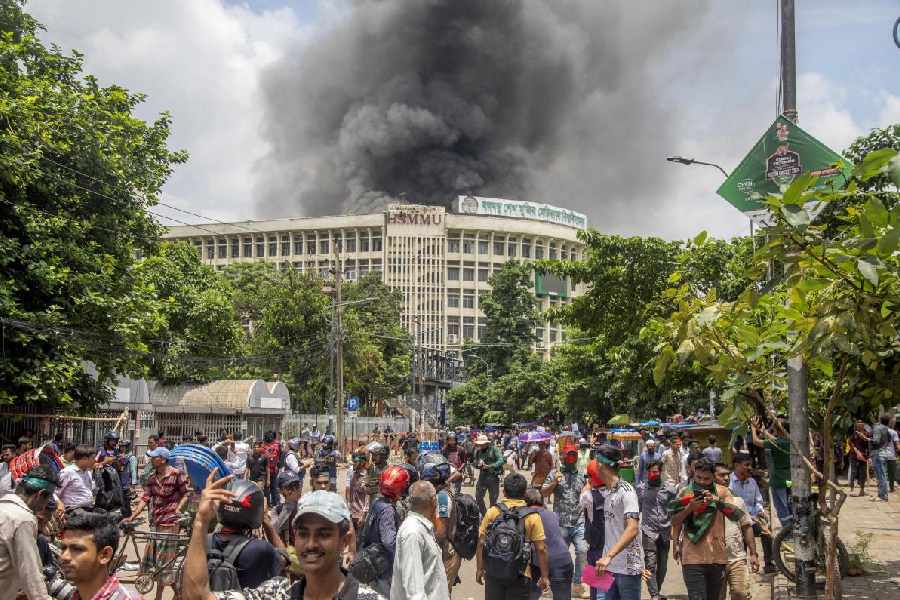What began as peaceful protests by students in Bangladesh against a quota system for government jobs has turned into an unprecedented challenge and rebellion against Prime Minister Sheikh Hasina and her ruling Awami League party. This timeline charts the dramatic evolution from initial demonstrations to a sweeping rebellion.
June 5: The High court reestablished the 30% job quota reservations of the civil service posts for the children and grandchildren of the freedom fighters who fought in the Bangladesh Liberation War. Six universities participated in peaceful protests against the quota ruling.
July 1: University students blocked roads and railways, building barricades to demand reforms of the quota system for sought-after public sector jobs. Sheikh Hasina said the students were ‘wasting their time’.
July 10: A protest march commenced in University of Dhaka in front of the library, passed by the Raju Memorial Sculpture, and culminated in the blockage of the Shahbagh intersection. Members of the law and order forces positioned barricades in front of the students.
July 12: Students gathered at Shahbagh and staged a blockade. While students were protesting at Comilla Victoria College, a group of Chhatra League members launched an attack on the protesters.
July 13: Students protested by blocking the railway tracks in Rajshahi. Dhaka University students held a press conference in the evening, where they complained that attempts were being made to block the students' movement with lawsuits.
July 14: The Bangladeshi government instructed a shut down of the 4G network in the University of Dhaka area. Later that night, leaders and members of the Bangladesh Chhatra League attacked protesters at the University of Chittagong injuring 13 protesters.
July 15: Chhatra League and other ruling activists attack quota protesters at Dhaka University. They also attack wounded demonstrators inside and outside Dhaka Medical College Hospital. As a result more than 300 students were injured on both sides.
July 16: At least six killed in fierce clashes between protesting students and law enforcers joined by ruling party activists in Dhaka, Chattogram and Rangpur.
July 17: Clashes erupted with police after the funeral prayer program organized by the student protesters, BNP and other parties to honor six individuals killed on 16 July for the quota reform movement.
July 18: Protesters chant "down with the dictator" and torch the headquarters of state broadcaster Bangladesh Television and dozens of other government buildings.
The government imposes an internet blackout.
At least 32 people are killed and hundreds are injured in clashes, which continue in the following days despite a curfew and the deployment of soldiers.
July 19: Government announces nationwide curfew and deploys army after daylong violence kills at least 66 people.
July 20: At least 21 killed on the first day of curfew amid army deployment.
July 21: Bangladesh's Supreme Court rules the decision to reintroduce job quotas was illegal.
July 22: Six more hurt in previous days' clashes die, taking the death toll to 146.
July 23: The Minister of State for Information and Broadcasting announced that the government would restore broadband internet service partially to banks, business organizations, export sectors, and selected areas after a five-day disruption.
July 24: Internet services were restored.
July 25: Sheikh Hasina makes her first public appearance since army deployment and visits damaged metro rail services.
July 26: Sheikh Hasina visits Dhaka Medical College Hospital on the second day of public appearance after the curfew announcement.
July 27: Sheikh Hasina visits Pongu Hospital, says violence was committed to cripple economy
July 28: Mobile internet service was restored in Bangladesh.
July 29: Protesters resumed large-scale demonstrations across various regions of the country after the government ignored an ultimatum to release their leaders. Police arrested more than 2000 students in Dhaka.
July 30: In a cabinet meeting on July 29, the Bangladesh Prime Minister announced that nationwide mourning will be observed on 30 July to honor those killed during the quota reform movement.
While Awami League leaders posted black profile pictures on Facebook, many users in Bangladesh chose red, rejecting the official mourning as a farce and declaring they will mourn only when justice is served for the dead students.
July 31: The Anti-Discrimination Student Movement organized a nationwide protest named "March for Justice" in response to the series of killings, mass arrests, attacks, lawsuits, enforced disappearances, and murders of students and citizens.
Aug 1: Government issues gazette banning Jamaat-Shibir under anti-terrorism act.
Aug 2: The protesters sought justice for victims affected by the unrest and police crackdown following the release of student leaders. Demonstrators demanded the reopening of schools and universities across the country and called for Sheikh Hasina's resignation.
Clashes occurred as police fired rubber bullets, tear gas shells, and sound grenades in several locations.
Aug 3: As a last resort to quell the protests, PM Sheikh Hasina proposed peaceful talks with the protesters, stating that her office was open and expressing a desire to "sit with the quota protesters and listen to them.
Aug 4: Hundreds of thousands of Bangladeshi protesters clash again with government supporters. Police say at least 14 officers are among the 68 killed.
Aug 5: Military takes over as Sheikh Hasina resigns; army chief addresses country.
Bangladesh's former Prime Minister Sheikh Hasina landed in India's northeastern city of Agartala on Monday after fleeing Dhaka.
The Awami League office of Hasina in Dhanmandi torched by protesters.










